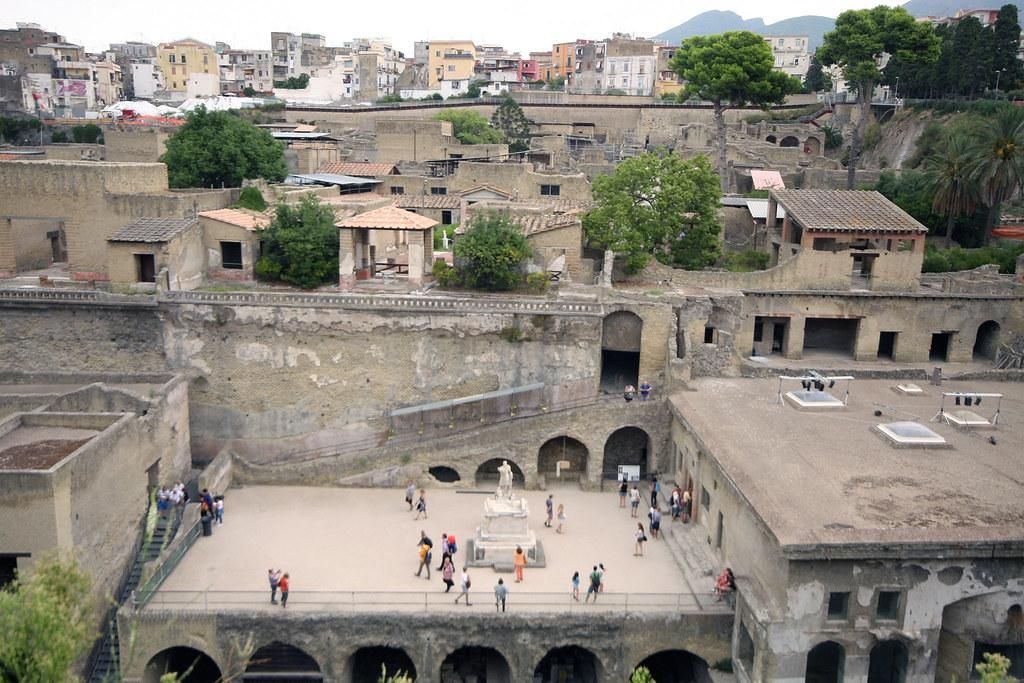Vesuvius Victim Identified as Elite Roman Soldier Sent on Failed Rescue Mission
The man may have been a Praetorian Guard dispatched by Pliny the Elder to save Herculaneum’s residents from the volcanic eruption
:focal(1044x584:1045x585)/https://tf-cmsv2-smithsonianmag-media.s3.amazonaws.com/filer/f5/ca/f5caf644-1258-44fc-8c98-c953be306731/destruction_of_pompeii_and_herculaneum.jpeg)
A new analysis of a man killed by the eruption of Mount Vesuvius suggests that he was most likely an elite Roman soldier sent on an unsuccessful mission to rescue refugees from the natural disaster.
As Claudio Lavanga reports for NBC News, the man’s skeleton was one of about 300 found at a beach in the ancient town of Herculaneum in the 1980s. Like neighboring Pompeii, Herculaneum was a popular seaside destination for ancient Romans. Both cities were destroyed by Vesuvius’ eruption in 79 A.D.
“When I arrived at Herculaneum in 2017, I realized that a lot of research went into the skeletons, but nobody thought of analyzing the tools found next to it,” Francesco Sirano, director of the archaeological site at Herculaneum, tells NBC News. “So my team and I took a closer look, and what we found was astonishing.”
Unlike the rest of the skeletons found at the site, the man wore a leather belt and had a bagful of coins, an ornate dagger and a sword with an iron hilt. Further analysis shows that the belt was decorated with images of a lion and a cherub; the sword’s scabbard, meanwhile, bore the likeness of an oval shield. Sirano says these motifs could be clues that the man was a member of the Praetorian Guard, an elite military force whose duties included guarding Roman emperors.
“Praetorians wore oval shields,” Sirano explains. “And the coins he had on him were coincidentally the same amount of a praetorian’s monthly wage.”

The 40- to 45-year-old man, who was probably in good health at the time of his death, was found facedown in the sand. Per BBC News, he was probably thrown to the ground by a volcanic blast. A boat was recovered nearby.
“He may be an officer of the fleet that took part in the rescue mission launched by Pliny the Elder to help the people in the towns and villas nestled on this part of the Bay of Naples,” Sirano tells the Agenzia Nazionale Stampa Associata (ANSA).
According to the Western Australian Museum, Pliny was a scholar with an interest in natural phenomena, as well as the commander of the Roman naval base at Misenum, on the Bay of Naples. According to accounts written by his nephew, Pliny the Younger, the older man saw a strange cloud rising from the mountain when Vesuvius began erupting. He ordered a galley to prepare to sail over to investigate. Then, he received a message from his friend Rectina begging to be rescued from her villa at the foot of the mountain.
“He changed his plans, and what he had begun in a spirit of inquiry he completed as a hero,” Pliny the Younger wrote. “He gave orders for the warships to be launched and went on board himself with the intention of bringing help to many more people besides Rectina, for this lovely stretch of coast was thickly populated.”
Pliny took naval quadriremes, the largest ships in his fleet, on the three-and-a-half hour trip across the bay. By the time they arrived, the situation was becoming more dire.
/https://tf-cmsv2-smithsonianmag-media.s3.amazonaws.com/filer/d0/38/d038d83b-2f0a-4935-a504-14fbd2142320/2560px-neptune_amphitrite_mosaic_herculaneum.jpeg)
“Ashes were already falling, hotter and thicker as the ships drew near, followed by bits of pumice and blackened stones, charred and craked by the flames,” Pliny the Younger added. “… For a moment my uncle wondered whether to turn back, but when the helmsman advised this he refused.”
Pliny’s ship reached the shore but was unable to set back out due to unfavorable winds. He perished in the disaster. Archaeologists theorize that a body discovered near the shore about a century ago is his, as Ariel David reported for Haaretz last year. Whether the ships that Pliny sent out successfully rescued anyone is unclear.
While many people in Pompeii and Herculaneum died instantaneously, some were able to escape. The full destruction of Pompeii took three days, Miami University historian Steven Tuck told Jennifer Ouellette of Ars Technica in 2019.
“Anybody who left immediately, or who was out of town on business, survived,” Tuck added.
Some victims survived the initial eruption, only to die in a second volcanic blast the following day. Last year, researchers from the Archaeological Park of Pompeii revealed the remains of two such men, eerily frozen in their final death throes. Based on the victims’ clenched feet and hands, the team posited that the duo succumbed to thermal shock caused by a rush of heat and volcanic debris.
In Herculaneum, Sirano and his colleagues are continuing to search for clues about what happened to the destroyed town. Per ANSA, they are now starting a new excavation project at the ancient beach.
/https://tf-cmsv2-smithsonianmag-media.s3.amazonaws.com/accounts/headshot/Livia_lg_thumbnail.png)
/https://tf-cmsv2-smithsonianmag-media.s3.amazonaws.com/accounts/headshot/Livia_lg_thumbnail.png)